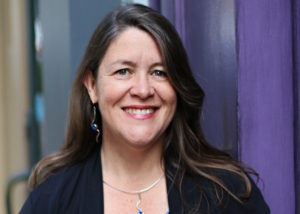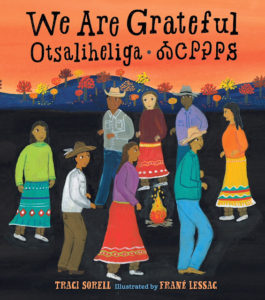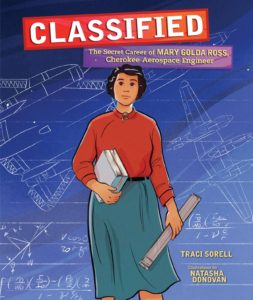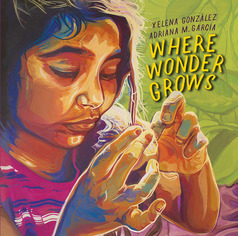
The February 2022 Author Interview at OPB is with Traci Sorell. She writes fiction and nonfiction books as well as poems for children “featuring contemporary characters and compelling biographies—the type of books I sought out in my school and public libraries as a child.” She’s an enrolled citizen of the Cherokee Nation and lives in NE Oklahoma where her tribe is located.
In addition to four published picture books and one middle grade novel, Traci is under contract for a half dozen more books to be published in the next year or so. Talk about being prolific!
And just because these are awesome, here are three Fun Facts about Traci:
- When she was 8, she tried out for the lead role in the 1982 film Annie.
- During college, she lived in Madrid for a year and taught English to Spanish children and adults.
- She is absolutely, profoundly unable to whistle.
With that, let’s move on to the interview.
https://twitter.com/tracisorell
https://www.facebook.com/TraciSorellAuthor/
RVC: What was it like growing up in the Cherokee Nation?
TS: It was very different than it is now. Like many other Native Nations at that time (1970s-1980s), the Cherokee Nation could not exercise its sovereignty and provide services to its citizens or others living within its reservation the way it can now. Tribal leaders and their citizens nationwide worked hard to challenge federal and state laws and policies that undermined our inherent rights as politically distinct peoples within the United States. So, I’m grateful my son has a completely different experience growing up in the Cherokee Nation today than I did as a child. He can experience the focus on language revitalization, participating in cultural programs, and being involved in community life with support from the central tribal government. When I grew up, only one’s family and community provided that because there wasn’t a stronger central government to serve as a support like there is now.
RVC: I’m glad to hear that! How much of a part of your daily life are stories?
TS: All of it. My entire day is filled with stories I tell myself, those I hear from others, and the ones I write. Stories are what we’re all made up of in this life and hopefully help us make sense of it.
RVC: When did you get interested in writing for children?
TS: Just before my son entered preschool, I began to examine the large collection of picture books I had related to Native Nations. I found very few focused on contemporary life and even fewer were created by citizens of Native Nations. I started researching to see what had been more recently published to determine if most of my books were just too old or anomalies, but that wasn’t the case. Overwhelmingly, even the current books featured pre-1900 life and failed to represent us in our full humanity. I decided I needed to figure out how to be part of the solution to this huge problem.
RVC: To address that problem by creating your own books, what kind of research or training did you do?
TS: A friend from graduate school told me to join SCBWI and connect to my local chapter because he believed the organization was good for helping people new to the field. At the time (2013), I lived in the Kansas City area where there are a lot of people writing and illustrating for young people. I found some wonderful mentors in my local region. I learned so much at our conferences and at other regional conferences from people across the industry.
RVC: How important is it for young kidlit writers to join SCBWI?
TS: I think that depends on your background and what you feel you need. I had no creative writing or English degrees. My prior work had been in completely different areas. I also didn’t know anyone writing in the kidlit field full time. Now there are mentorship programs, helpful info websites like kidlit411.com, classes from Highlights Foundation and The Writing Barn, and kidlit-focused Facebook groups that someone can connect with much more easily for the information and communities they need. For BIPOC creators, Kweli Journal’s Color of Children’s Literature conference is a terrific place to connect with fellow creatives at all levels of publishing experience as well as meet agents and editors. So, I don’t know that SCBWI membership is as critical given the broader array of supports and information available today.
 RVC: What’s the story of how your debut picture book, We Are Grateful: Otsaliheliga, came about?
RVC: What’s the story of how your debut picture book, We Are Grateful: Otsaliheliga, came about?
TS: In the fall of 2015, I won a free Skype critique from Suzanne Slade, a prolific, award-winning nonfiction author, and had no manuscript to show her. So, I sketched out the story, wrote it up, and met with her in November. She suggested a few revisions and told me to get it out to publishers. It was the quickest book I’ve ever written. I sold it unagented through the slush pile in March 2016.
RVC: I’m not surprised that Suzanne’s notes helped you get that book ready to succeed–we know how good Suzanne is (we did an interview with her in 2019). Now, what’s your favorite thing about We Are Grateful: Otsaliheliga?
TS: I have two. First, I’m still hearing from Cherokee people that they love seeing us just living our contemporary lives and doing what we do represented in a picture book because there had never been one previously.
Second, the team of people I worked with to craft the book from fellow Cherokee Nation citizens and veteran illustrator Franè Lessac to my editor Karen Boss and the entire Charlesbridge team, everyone made me feel so supported that I wanted to write more and become a part of this industry.
 RVC: You had a new book come out last year at this time—Classified: The Secret Career of Mary Golda Ross, Cherokee Aerospace Engineer. What are some of the things you did in terms of PR to support the book?
RVC: You had a new book come out last year at this time—Classified: The Secret Career of Mary Golda Ross, Cherokee Aerospace Engineer. What are some of the things you did in terms of PR to support the book?
TS: It was difficult to launch a book into the world that I couldn’t share with anyone in person. Since I didn’t have any 2020 releases, I hadn’t experienced that previously. So, I launched a preorder campaign with Birchbark Books (Native-owned indie bookstore in Minneapolis). Every preordered book received a bookplate sticker featuring art from the book and signed by the illustrator Natasha Donovan and myself. I also created twenty-five golden tickets that would be randomly placed in the preordered books. Those receiving a golden ticket inside their book contacted me, and I’d mail them a $1 2019 gold coin issued by the US Mint to commemorate Native contributions in space. Both Mary Golda Ross and NASA astronaut John Herrington (Chickasaw) are featured on the coin.
RVC: That’s a terrific idea–so different than I normally see from authors.
TS: I did some podcast and blog interviews, too. I also got in touch with the Society of Women Engineers, the national organization that Mary was very active in, and they helped promote the book within their networks.
RVC: What’s the most important thing people should know or understand about Mary?
TS: Into every space Mary entered, she brought her Cherokee identity and values with her. Those allowed her to develop her incredible math abilities for the betterment of us all.
RVC: One of the challenges of a picture book biography is that you simply can’t squeeze everything into it. So, what’s something cool about Mary that just didn’t make the final cut?
TS: Her mother donated part of her land to have a one-room schoolhouse built where her children, her nieces and nephews and others living in the area could attend school close to home. As a result, Mary was not sent off to a boarding school like some Cherokee and many Native children from different tribes were at the time. I believe that act made a difference in Mary’s life.
RVC: If you had to summarize the most important thing you’ve learned about picture book writing while writing Classified, what would it be?
TS: Trust your gut instincts. Forget what your head says. From the structure to the research to co-creating the book, I just trusted that the through line I wrote for Mary’s story would connect with readers.
RVC: Let’s talk process. What does your writing process look like?
TS: I start out as a plotter. I’ll make notes, usually create a mind map, and then sketch out a rough outline. Then, as I’m writing, a looser style comes in because the story evolves as it needs to be based on the through line I’ve created. I write in my office and, when I’m close to a deadline, I’ll head to a hotel about twenty minutes from my home for a long weekend. I take the food and water I need, so I have uninterrupted time to just read, edit, and sit with the story to finalize the draft or make the revisions.
RVC: [Making a note to try writing and editing in a hotel–ideally a 5‑star fancy one.] What’s your writing superpower?
TS: I believe it’s crafting lyrical, accessible text to create connection and inform or provoke greater understanding of what previously may not have been visible or well understood.
RVC: You’ve got a lot of books under contract and you’re doing a lot of other things in your life. How do you stay so prolific?
TS: I like variety, so I challenge myself to write in new formats and for different age groups. If I wasn’t doing that, I don’t think I’d have as many books as I do. It’s just how I’m hardwired.
RVC: Since COVID, I’ve always tried to ask a question about health and wellness in every interview, so here’s yours—What works best when you need to de-stress?
TS: I listen to music, dance, and nap.
RVC: That’s a great combo of things, for sure. Now, just one last question for this part of the interview, Traci. What forthcoming projects are you most excited about?
TS: All of them. Each one I thought up or a fellow creative did, and they are all stretching me in new ways.
RVC: Okay, Traci, it’s time for the LIGHTNING ROUND. Cracking-fast questions and express-swift answers, please. Are you prepared?
TS: Definitely.
RVC: What’s the funniest word in the English language?
TS: Cockamamie, then cattywampus.
RVC: What secret talent do you have that no one would suspect?
TS: I’m a good dancer–salsa, merengue, swing, etc.
RVC: 5 things you can’t do your job without?
TS: Easy–the support of my peeps, pencil, paper calendar, laptop, and smartphone.
RVC: A recent picture book that really got your attention?
 TS: Where Wonder Grows, written by Xelena González and illustrated by Adriana M. Garcia (Lee and Low). I love that the idea from the story came from students who showed their rocks to the two creators during school visits. It prompted them to create an intergenerational story between a Native grandmother and her granddaughters that informs readers that rocks are beings and what different roles they have in our world. It’s very visually arresting, too. I just love it!
TS: Where Wonder Grows, written by Xelena González and illustrated by Adriana M. Garcia (Lee and Low). I love that the idea from the story came from students who showed their rocks to the two creators during school visits. It prompted them to create an intergenerational story between a Native grandmother and her granddaughters that informs readers that rocks are beings and what different roles they have in our world. It’s very visually arresting, too. I just love it!
RVC: Your mission as a kidlit author?
TS: To combat the erasure and invisibility of Native Nations and their citizens while centering their humanity, sovereignty, histories, cultures, and languages in trade-published literature for young people in both fiction and nonfiction. That mission isn’t just about works I create, but also helping other Native creatives get their work in front of young people too.
RVC: Favorite expression/quote about writing?
TS: “I’m not entangled in shaping my work according to other people’s views of how I should have done it.” ~Toni Morrison
RVC: Thanks so much, Traci!

